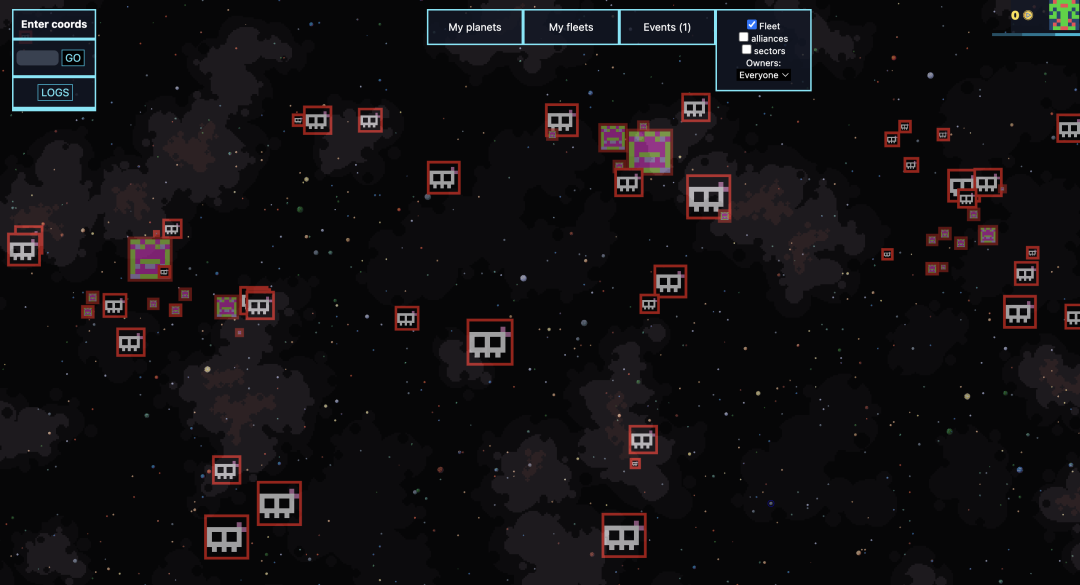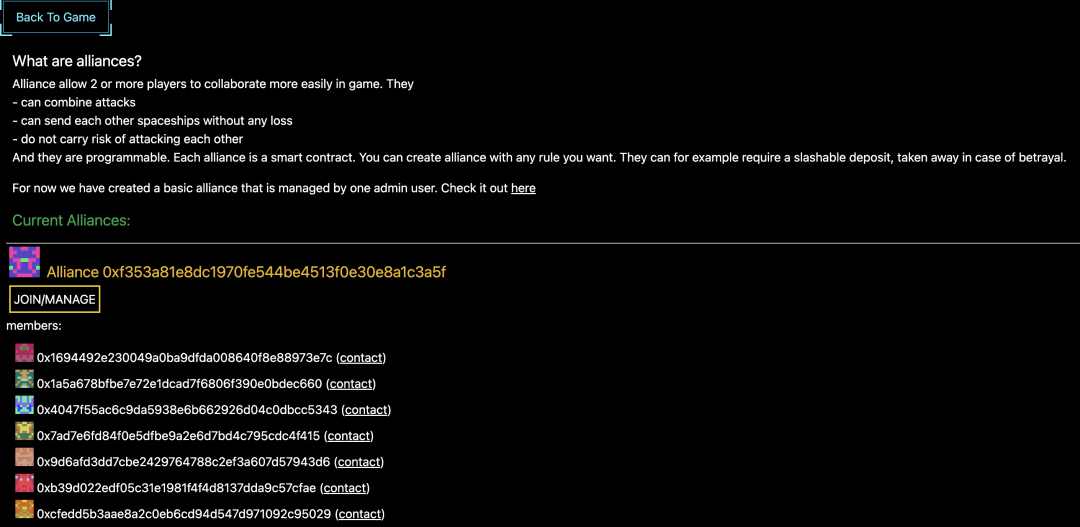
Conquest.eth is a full-chain game with a “long history”.
According to the information released by the official in the latest blog post this month titled “Conquest.eth is now open-source! And There is $1000 to grab in Outer SLianGuaice!”[1], Conquest.eth has now open-sourced all of its code[2] and the development team has voluntarily relinquished the upgrade permission of the game contract[3]. In a sense, this signifies the official end of the development progress of this game that has not generated much response.
So, what unique gameplay does this game, which is similar to “The Dark Forest”, have? Why couldn’t it achieve the same impact as “The Dark Forest”? And what experiences can later teams learn from it?
- Tencent ShuZang suspends operations, players have no way to protect their rights
- New Project Outlook | Reserve Creating a Stable Asset-Backed Currency to Combat Inflation
- The Block An Inventory of 5 Innovative Projects Worth Paying Attention to
01. Introduction to Basic Game Mechanics
According to the official team’s definition, Conquest.eth is a game of diplomacy, where players’ goal is to compete for control of the entire universe. Like other full-chain games, all the logic and state of Conquest.eth are written on the chain. However, unlike many similar projects currently, Conquest.eth is designed to be able to run indefinitely, so as long as the underlying public chain continues to produce blocks, the Conquest.eth game will also exist forever.
Therefore, Conquest.eth is both a game and a protocol, or, to use a more common term nowadays, it is more like an autonomous world.
Basic Gameplay
Currently, Conquest.eth runs on Gnosis Chain (formerly xDai). When players enter the game, they need to first select an unowned planet and occupy it by staking a certain amount of tokens (xDai) (to prevent witch attacks). Of course, if your planet is not taken by other players in the game, the staked tokens can be withdrawn back to the player’s wallet when the player exits the game, but it requires an additional three days of waiting time.

Once you occupy your first planet, the planet will automatically generate spaceships (represented by the number of spaceships on the planet), and then players can use these spaceships for defense and attack. Its basic gameplay is very similar to “The Dark Forest”, so I won’t go into too much detail here.
In the map below, each planet occupied by a real player will display a separate symbol (planets owned by the same address have the same symbol). And if a player wants to plunder the funds staked by other players on a planet, they should first attack the already occupied planet, rather than occupying other unowned territories (these unowned planets can be directly obtained by staking funds and do not need to be occupied in advance).

By now, you probably already have a rough understanding of why this game is not as fun as “The Dark Forest” with a similar game mechanism. Yes, the introduction of the Stake mechanism greatly limits the space for players to play in the game. Occupying unowned planets becomes less meaningful, and players can only enjoy themselves through interaction with other players. Perhaps this is why Conquest.eth is called a diplomatic strategy game.
However, in the current final version of the game map, the development team of Conquest.eth has left a “treasure” for all players in the map before leaving. A total of $1,000 worth of funds has been staked in different planets in the universe (the planets covered by the skull symbol in the image). Real players attacking these planets do not need to worry about retaliation and can confidently occupy and withdraw funds.
02. Development Team

The development team behind Conquest.eth, Etherplay, is also a team worth mentioning in the field of blockchain games. Etherplay is based in Scotland and has been focusing on blockchain games (mainly full-chain games) since its establishment in 2016, without adjusting its direction much during two bull and bear cycles.
The founder of the team is Ronan Sandford (Twitter: @wighawag). According to the information revealed in his latest project “Stratagems” on GitHub [4], the team currently consists of only him.

After its establishment, Etherplay developed the first game integrated with Metamask and then started to focus on developing perpetual and permissionless games (now also known as autonomous worlds). This includes “Tug of War” [5], “Ethernal” [6], and “Conquest.eth” [7].
In addition, Etherplay is also developing a new game project, “Stratagems” [8]. This game will mainly explore concepts such as permissionless composability and immutable rule sets, and is currently in the testing phase.
03. What experiences does Conquest.eth have that are worth learning from?
As a full-chain game product that started earlier and has very similar game mechanics to “The Dark Forest”, Conquest.eth not only did not arouse the enthusiasm of the player community like “The Dark Forest”, but also has a weak presence in the current full-chain game community. So what mistakes did it make in the design of its core game mechanics, and what experiences are worth learning from?
First, Conquest.eth may not have truly achieved Permissionless as it claims. Its representative Stake to Play mechanism greatly increases the barrier for entry for ordinary users.
We can compare other full-chain gaming projects that adopt the Stake to Play mechanism. Taking Rhascau (a full-chain flying chess game) as an example, the Stake mechanism designed in the game is not necessary for players, just like when we play cards, we can freely choose whether to play with money or without money. The Stake mechanism is just an optional feature that provides players with added fun to the game. On the other hand, Conquest.eth uses Stake as a means to prevent witch attacks, and this approach seems to resemble the design thinking of consortium chains, which seems to deviate from the core spirit of blockchain.
Of course, at this stage, we may not have a mature mechanism that can both prevent witch attacks and ensure the sustainable operation of the game. Perhaps future full-chain games can explore a method of reducing the negative impact of witch attacks through protocol-level gaming, rather than directly increasing the user’s entry threshold through Stake.
Nevertheless, I believe that Conquest.eth still has certain reference value in certain core game design concepts. For example, it believes that full-chain games (or autonomous worlds) should have persistence like underlying public chains, rather than the turn-based system adopted by many full-chain games currently (successful ones like Dark Forest and SkyStrife both use the turn-based system).
After all, the inherent “unreliability” in the turn-based system, which includes admission restrictions and “untrustworthiness” in the temporal dimension, does not meet the basic requirements of decentralized protocols. This inherent “unreliability” in the turn-based system also increases the difficulty of subsequent protocol interoperability to some extent. It’s like nowadays, it’s hard to imagine how to combine a DeFi protocol with transaction time limits.
In addition, Conquest.eth is also exploring the on-chain alliance system for full-chain games. However, because no one has been willing to try it out together, I haven’t had the chance to experience the relevant functions. But I believe that the alliance system will also become an essential component of future full-chain games.

At the end of the article, I still recommend friends who have time to experience Conquest.eth. After all, there is still a $1,000 reward provided by the team that no one has claimed. Based on my recent observations, the competition for these rewards is not very fierce at the moment, so if you are interested, you can give it a try.
Reference links:
[1]https://etherplay.io/blog/conquest-is-open-source/
[2]https://github.com/etherplay/conquest-eth
[3]https://gnosisscan.io/tx/0x4e432084b592e3e96598edfba253383c3ae98d68dade73c428dcd74da90bd2cf#eventlog
[4]https://github.com/wighawag/stratagems#readme
[5]https://etherplay.medium.com/our-first-unstopLianGuaible-game-tug-of-war-bb69c63a8734)
[6]https://ethernal.land/
[7]https://conquest.game/
[8]https://stratagems.world/
This HTML code includes two hyperlinks. The first hyperlink is [7]https://conquest.game/ and the second hyperlink is [8]https://stratagems.world/.
Like what you're reading? Subscribe to our top stories.
We will continue to update Gambling Chain; if you have any questions or suggestions, please contact us!